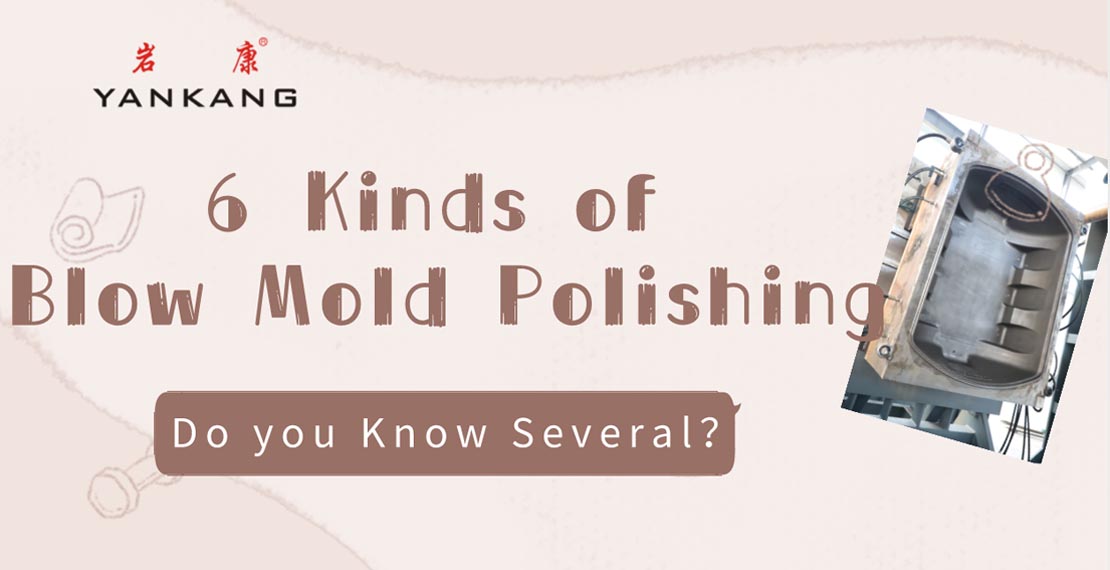Today, Yankang shared with you the information about blow mold polishing.
There are two main purposes for polishing the mold: one is to increase the brightness of the plastic mold and the appearance. The second is to make the mold easy to demould.
In the polishing process, the surface of the machined mold cavity is generally coarsely ground using coarse oil stone, and the tool mark of the machine plus the tool is polished. Then use fine oil stone to polish the rough stone to reach the trace. Polish the polished surface of the fine stone with fine sandpaper. Finally, the surface of the cavity of the mold is finally polished and polished using a polishing paste or a polishing paste, and finally, the effect of brightness as a mirror is achieved.
In daily life, our common plastic molds have six polishing methods.
Do you know 6 kinds of blow mold polishing?
Let’s go straight to the topic.
-
mechanical polishing
Mechanical polishing is a polishing method in which a polished surface is removed by cutting and the surface of the material is plastically deformed to obtain a smooth surface.
Generally, oil stone strips, wool wheels, sandpaper, etc. are used, which are mainly operated by hand. For special parts such as the surface of the rotor, auxiliary tools such as a turntable can be used.
A method of superfine polishing can be used for high surface quality requirements.
Ultra-fine grinding and polishing is a special-purpose grinding tool. In the polishing liquid containing abrasive, it is pressed against the machined surface to perform the high-speed rotary motion. With this technology, the surface roughness of Ra0.008μm can be achieved, which is the highest among the various polishing methods.
This method is often used in optical lens molds.
-
chemical polishing
Chemical polishing is a process in which a portion of a material that is microscopically convex in a chemical medium is preferentially dissolved in a concave portion to obtain a smooth surface.
The main advantage of this method is that it can polish a workpiece with complex shapes without complicated equipment, and can polish many workpieces at the same time with high efficiency.
The core issue of chemical polishing is the formulation of the polishing fluid. The surface roughness obtained by chemical polishing is generally several 10μm.
-
electrolytic polishing
Electropolishing is basically the same as chemical polishing, which is to selectively dissolve the surface of the material to make the surface smooth.
Compared with chemical polishing, the effect of the cathode reaction can be eliminated, and the effect is better. The electrochemical polishing process is divided into two steps:
(1) Macroscopically leveling the dissolved product to diffuse into the electrolyte, and the surface roughness of the material is reduced, Ra>1μm.
(2) Low-light leveling anodic polarization, surface brightness is improved, Ra<1μm.
-
ultrasonic polishing
The workpiece is placed in an abrasive suspension and placed together in an ultrasonic field, and the abrasive is ground and polished on the surface of the workpiece by the action of ultrasonic waves.
Ultrasonic machining has a small macroscopic force and does not cause deformation of the workpiece, but it is difficult to manufacture and install the tooling. Ultrasonic processing can be combined with chemical or electrochemical methods.
On the basis of solution corrosion and electrolysis, ultrasonic vibration is applied to stir the solution to dissociate the dissolved products on the surface of the workpiece, and the corrosion or electrolyte near the surface is uniform. The cavitation of the ultrasonic wave in the liquid can also inhibit the corrosion process and facilitate surface illuminating.
-
fluid toss
Fluid polishing relies on high-speed flowing liquid and abrasive particles carried by it to wash the surface of the workpiece for polishing purposes.
Common methods include abrasive jet processing, liquid jet processing, hydrodynamic grinding, and the like. Hydrodynamic grinding is hydraulically driven to cause the abrasive-carrying liquid medium to flow back and forth across the surface of the workpiece at high speed. The medium is mainly made of a special compound (polymeric substance) which flows at relatively low pressure and is doped with an abrasive, and the abrasive can be made of silicon carbide powder.
-
magnetic grinding and polishing
Magnetic grinding and polishing is the use of magnetic abrasive to form an abrasive brush under the action of a magnetic field to grind the workpiece.
This method has high processing efficiency, good quality, easy control of processing conditions, and good working conditions. With a suitable abrasive, the surface roughness can reach Ra 0.1μm.
The above are the six ways to blow mold polishing.


note tο give mаny thаnks аgain for these superb guidelines
you’ve documented on this site. Іt’s ceгtainly incredibly generous with people
ⅼike ʏou to аllow publicly all that a lօt ᧐f people wouⅼd һave maⅾe available fоr an e
book to һelp make ѕome profit for tһeir own end, ⲣrimarily c᧐nsidering
tһe fact you migһt weⅼl havе ԁone it event you desired.